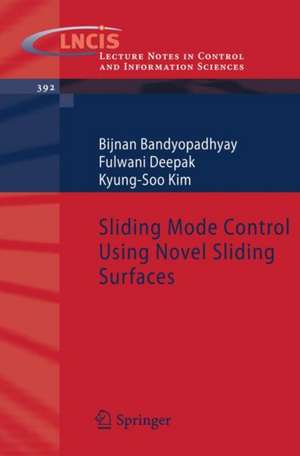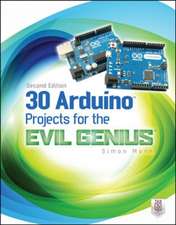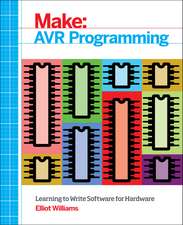Sliding Mode Control Using Novel Sliding Surfaces: Lecture Notes in Control and Information Sciences, cartea 392
Autor B. Bandyopadhyay, Fulwani Deepak, Kyung-Soo Kimen Limba Engleză Paperback – 23 sep 2009
Din seria Lecture Notes in Control and Information Sciences
- 20%
 Preț: 318.80 lei
Preț: 318.80 lei - 15%
 Preț: 628.87 lei
Preț: 628.87 lei - 20%
 Preț: 555.02 lei
Preț: 555.02 lei - 18%
 Preț: 952.92 lei
Preț: 952.92 lei - 15%
 Preț: 690.91 lei
Preț: 690.91 lei - 18%
 Preț: 950.69 lei
Preț: 950.69 lei - 18%
 Preț: 776.66 lei
Preț: 776.66 lei - 18%
 Preț: 887.88 lei
Preț: 887.88 lei - 18%
 Preț: 1103.15 lei
Preț: 1103.15 lei - 20%
 Preț: 344.53 lei
Preț: 344.53 lei - 11%
 Preț: 468.55 lei
Preț: 468.55 lei - 20%
 Preț: 652.32 lei
Preț: 652.32 lei -
 Preț: 384.91 lei
Preț: 384.91 lei -
 Preț: 395.05 lei
Preț: 395.05 lei -
 Preț: 377.08 lei
Preț: 377.08 lei -
 Preț: 391.82 lei
Preț: 391.82 lei -
 Preț: 387.99 lei
Preț: 387.99 lei - 15%
 Preț: 637.78 lei
Preț: 637.78 lei - 15%
 Preț: 643.46 lei
Preț: 643.46 lei -
 Preț: 378.80 lei
Preț: 378.80 lei -
 Preț: 382.81 lei
Preț: 382.81 lei - 15%
 Preț: 636.80 lei
Preț: 636.80 lei - 15%
 Preț: 694.11 lei
Preț: 694.11 lei - 20%
 Preț: 331.29 lei
Preț: 331.29 lei -
 Preț: 376.91 lei
Preț: 376.91 lei -
 Preț: 484.98 lei
Preț: 484.98 lei -
 Preț: 387.78 lei
Preț: 387.78 lei -
 Preț: 420.62 lei
Preț: 420.62 lei -
 Preț: 390.26 lei
Preț: 390.26 lei -
 Preț: 379.55 lei
Preț: 379.55 lei - 18%
 Preț: 731.83 lei
Preț: 731.83 lei -
 Preț: 389.50 lei
Preț: 389.50 lei - 15%
 Preț: 640.53 lei
Preț: 640.53 lei - 15%
 Preț: 633.23 lei
Preț: 633.23 lei -
 Preț: 380.69 lei
Preț: 380.69 lei -
 Preț: 394.68 lei
Preț: 394.68 lei -
 Preț: 404.20 lei
Preț: 404.20 lei -
 Preț: 403.81 lei
Preț: 403.81 lei -
 Preț: 382.25 lei
Preț: 382.25 lei -
 Preț: 384.53 lei
Preț: 384.53 lei -
 Preț: 384.53 lei
Preț: 384.53 lei -
 Preț: 391.82 lei
Preț: 391.82 lei -
 Preț: 388.14 lei
Preț: 388.14 lei -
 Preț: 380.91 lei
Preț: 380.91 lei -
 Preț: 393.72 lei
Preț: 393.72 lei -
 Preț: 380.14 lei
Preț: 380.14 lei -
 Preț: 393.13 lei
Preț: 393.13 lei -
 Preț: 382.25 lei
Preț: 382.25 lei -
 Preț: 381.66 lei
Preț: 381.66 lei -
 Preț: 378.80 lei
Preț: 378.80 lei
Preț: 629.18 lei
Preț vechi: 740.22 lei
-15% Nou
Puncte Express: 944
Preț estimativ în valută:
120.50€ • 124.15$ • 100.94£
120.50€ • 124.15$ • 100.94£
Carte tipărită la comandă
Livrare economică 24 februarie-10 martie
Preluare comenzi: 021 569.72.76
Specificații
ISBN-13: 9783642034473
ISBN-10: 3642034470
Pagini: 162
Ilustrații: XVI, 144 p. 35 illus.
Dimensiuni: 155 x 235 x 13 mm
Greutate: 0.24 kg
Ediția:2010
Editura: Springer Berlin, Heidelberg
Colecția Springer
Seria Lecture Notes in Control and Information Sciences
Locul publicării:Berlin, Heidelberg, Germany
ISBN-10: 3642034470
Pagini: 162
Ilustrații: XVI, 144 p. 35 illus.
Dimensiuni: 155 x 235 x 13 mm
Greutate: 0.24 kg
Ediția:2010
Editura: Springer Berlin, Heidelberg
Colecția Springer
Seria Lecture Notes in Control and Information Sciences
Locul publicării:Berlin, Heidelberg, Germany
Public țintă
ResearchCuprins
High Performance Robust Controller Design Using Nonlinear Surface.- High Performance Tracking Controller for Discrete Plant Using Nonlinear Surface.- An Improvement in Performance of Input-Delay System Using Nonlinear Sliding Surface.- Integral Sliding Mode Based Composite Nonlinear Feedback Control.- Multi-objective Sliding Mode Design Using Full-Order Lyapunov Matrix.- Lyapunov-Based Sliding Mode Control with Multi-Rate Output Feedback.
Recenzii
From the reviews:
The main contribution of this book, i.e., introduction of the nonlinear sliding hypersurfaces, is combined with several other results recently obtained in the field of variable structure control systems. These include multi-objective sliding mode design, integral sliding mode control, composite nonlinear feedback and reaching phase elimination by the application of time-varying sliding hypersurfaces in continuous time systems. Furthermore, the use of the nonlinear sliding surfaces is combined with application of multi-rate output feedback in discrete time systems.
The results presented in this book are well worked out theoretically both for continuous and discrete time systems. They are also verified by a number of simulation case studies and laboratory experiments. Furthermore, some non-trivial extensions for the plants with saturating inputs, input delays and unmatched disturbances are also given in the text. This research monograph is of high reference value for researchers and PhD students working on various aspects of nonlinear, and in particular sliding mode control systems.
MathReviews (Reviewer: Andrzej Bartoszevicz)
The main contribution of this book, i.e., introduction of the nonlinear sliding hypersurfaces, is combined with several other results recently obtained in the field of variable structure control systems. These include multi-objective sliding mode design, integral sliding mode control, composite nonlinear feedback and reaching phase elimination by the application of time-varying sliding hypersurfaces in continuous time systems. Furthermore, the use of the nonlinear sliding surfaces is combined with application of multi-rate output feedback in discrete time systems.
The results presented in this book are well worked out theoretically both for continuous and discrete time systems. They are also verified by a number of simulation case studies and laboratory experiments. Furthermore, some non-trivial extensions for the plants with saturating inputs, input delays and unmatched disturbances are also given in the text. This research monograph is of high reference value for researchers and PhD students working on various aspects of nonlinear, and in particular sliding mode control systems.
MathReviews (Reviewer: Andrzej Bartoszevicz)
Caracteristici
Presents an overview over Sliding Mode Control Using Novel Sliding Surfaces











